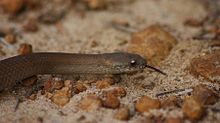Echiopsis
| Bardick | |
|---|---|

| |
| Scientific classification | |
| Domain: | Eukaryota |
| Kingdom: | Animalia |
| Phylum: | Chordata |
| Class: | Reptilia |
| Order: | Squamata |
| Suborder: | Serpentes |
| Family: | Elapidae |
| Genus: | Echiopsis Fitzinger, 1843 |
| Species: | E. curta
|
| Binomial name | |
| Echiopsis curta (Schlegel, 1843)
| |
Echiopsis curta is a
There is some dispute whether Echiopsis atriceps is also a species within the genus as only five known specimens have been found but have been assigned to four different genera.[5]
Description
The bardick grows up to maximum of 57 cm (1 ft 10.44 in) in length with a thick set stumpy body with a short tail.[6] Its smooth scales vary in color from pale to dark grey, brown and reddish, darker along the head and back, this lightens along the sides, with white to cream belly. Lips are spotted with white.[3][6] The bardick has short hollow fixed fangs which is uses to deliver toxic venom to its prey.[3]
Distribution and habitat
Echiopsis curta has three distinct populations in
It inhabits heath, scrubland and open forest in the west and favors mallee and Triodia grassland country in the eastern population.[6] They like to live under leaf litter, fallen trees and debris. The major threat to bardick numbers is due to loss of habitat from clearing.[7]
Diet
It is an ambush style predator which is mostly nocturnal in habit and a diet consisting of mainly lizards (52%), frogs (31%) and mammals (13%), plus some birds and insects.[8] Eastern populations eat less amphibians than western populations. Studies conducted on diet showed prey types contained multiple species of each type.[8]
Lifespan and reproduction
Bardicks are ovoviviparous, with litters ranging between 3 and 14 and averaging 7 young. These are born up to 15 cm in length. Mating occurs in late spring, gestation over summer and birthing in late summer and autumn. Males reach sexual maturity at 29 cm snout-vent length (SVL) at between 17 and 19 months of age.[8] Females reach reproductive age at 28 cm SVL at approximately 32 months of age. Body size is strongly correlated to reproductive fitness.[6] This species shows one of the largest litter volumes, a single specimen at 41 cm SVL had 13 full size embryos extending 34 cms internally, to 7cms from the snout.[8]
Venom
Research into venom of E. curta is extremely limited. There is some suggestion of similarities to the common death adder (Acanthophis antarcticus), due to a snake venom detection kit false positive on a dog, outside the geographical range of that species.[9] Bites on humans are rare, with one case requiring hospitalization due to complications which were abated with the administration of common death adder antivenom[10]
Venom has been shown to include neurotoxins and is highly neurotoxic to avian tissues, comparable to tiger snake, copperhead and inland taipan. However, it has not shown neurotoxic effects even though significant envenoming has occurred.[9]
References
- . Retrieved 19 November 2021.
- ^ JSTOR 1444827.
- ^ a b c d Cogger, Harold (1984). Reptiles in the Australian arid zone. Sydney: Australian Museum Sydney.
- doi:10.2305/iucn.uk.2017-3.rlts.t7013a83451904.en.)
{{cite journal}}: Cite journal requires|journal=(help - ISSN 0952-8369.
- ^ a b c d e PUBLISHING, CSIRO. Reptiles and Amphibians of Australia.
- ISSN 0006-3207.
- ^ JSTOR 1563569.
- ^ S2CID 32708453.
- S2CID 25983234.

